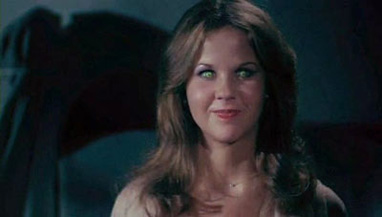Chapter Two
Exorcist II: The Heretic
By Brett Ballard-Beach
September 1, 2011
The plotlines did grow out of what came before but only through tangents that then took off for parts unknown. As frustrating as the viewing of both those proved to be, a part of me was also intrigued because (if you’ll allow for a fairly obvious truism) neither of them would exist if not for the unexpected success of another film and it is hard to imagine either one being made in isolation. But as expected as it might be in the 2000s for sequels to sleeper horror films to arrive and strike while the iron was hot (and, as was the case for Blair Witch and The Ring, for the iron to cool significantly and then crack and fall apart), in neither instance was anything as remotely crucial at stake as with Warner Bros’ release of Exorcist II: The Heretic in June 1977.
In December 1973, The Exorcist was released, and would eventually come to rival The Godfather as the highest grossing film of its time, raking in $440 million worldwide, when counting re-releases. It snagged ten Oscar nominations, including Picture, Director, three acting nods, Cinematography, and Editing, and won for Best Sound and Best Adapted Screenplay. Author William Peter Blatty, working off his own 1971 novel, provided the adaptation, and in a rare feat of ownership for a scribe, also produced the film. William Friedkin, fresh from another multiple Oscar nominee/winner (1971’s The French Connection) provided the direction and, if anecdotes from the set are truthful, kept the shooting as tightly wound as possible by firing off guns, and through physical intimidation and verbal abuse.
The film’s plot certainly put its 12-year-old protagonist Regan McNeil through hell as it charts her unexplained demonic possession and eventual exorcism at the hands of Father Merrin, as unwavering a man of faith and belief as one could imagine, and the more tormented Father Karras, suffering through the recent loss of his mother and a doubt about his relationship to the Church.
I find it hard to put myself back in the shoes of an audience encountering such a provocative and visceral piece of cinema for the first time. Perhaps jaded from decades of rip-offs and imitations, my thought on a recent reviewing is that it doesn’t strike me as particularly scary (and yet it continually tops or places near the summit on lists of the scariest films of all time). If it isn’t as shocking as it once was, it yet remains as raw and wounded as ever. The thought that people in attendance during the 2000 theatrical release of the Director’s Cut were laughing because they found it funny is upsetting to me. Friedkin and Blatty place their demonic action in a world that is defiantly and unapologetically real. The colors are muted; the skies are overcast and the superb Georgetown locations (the infamous flight of steps included) all seem to come with a damp chill in the architecture.
The haunted lead performances by Ellen Burstyn (as Chris, Reagan’s actress mother) and Jason Miller (as Karras) anchor the film. Both play caring and sensitive individuals who find themselves tested by events beyond the realm of easy explanation, and left wanting by their reactions. Veteran actor Lee J. Cobb as a police lieutenant investigating a mysterious death tied to the McNeil household seems the most extraneous character to the plot and yet his sole conversation with Chris ranks as the single best scene of dialogue in the film.
Continued:
1
2
3
4
5
|
|
|
|




